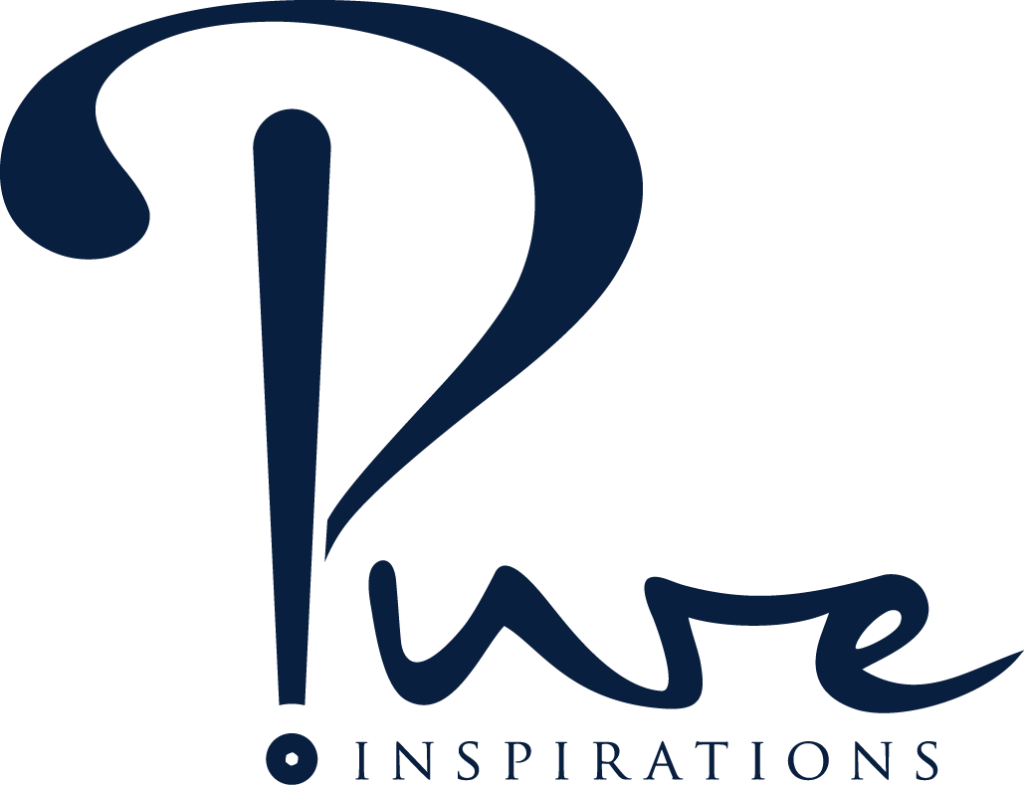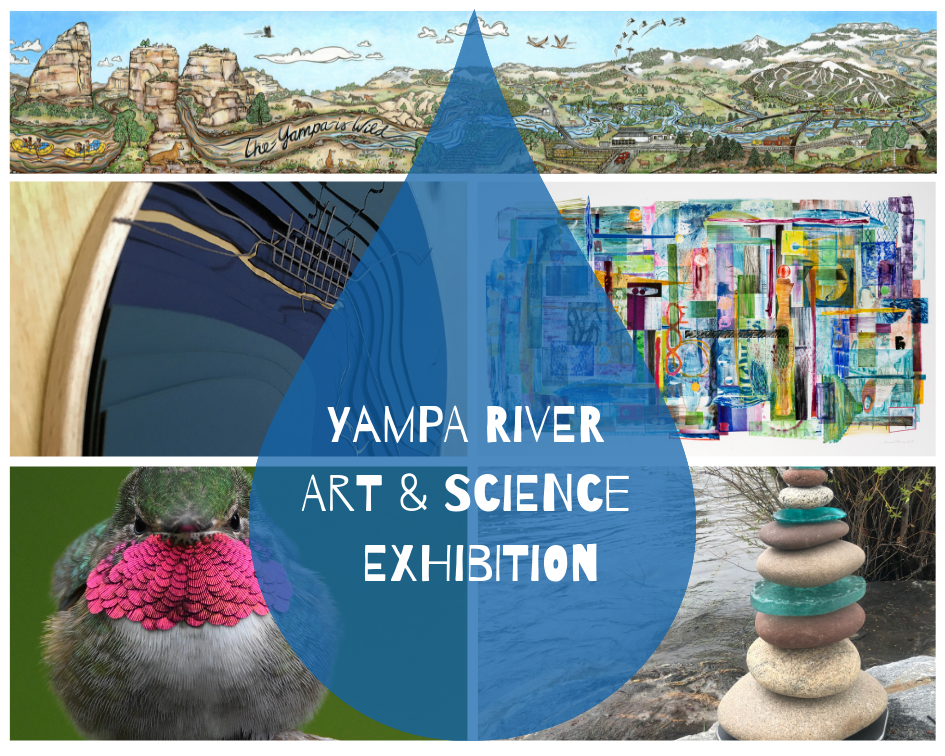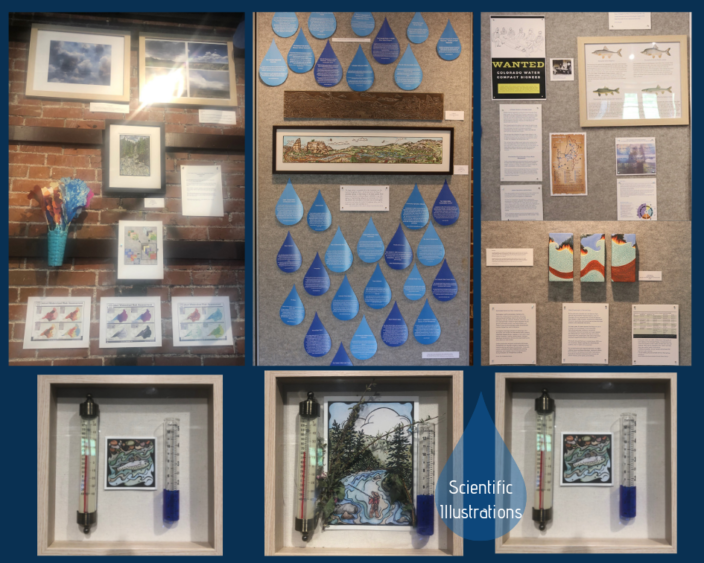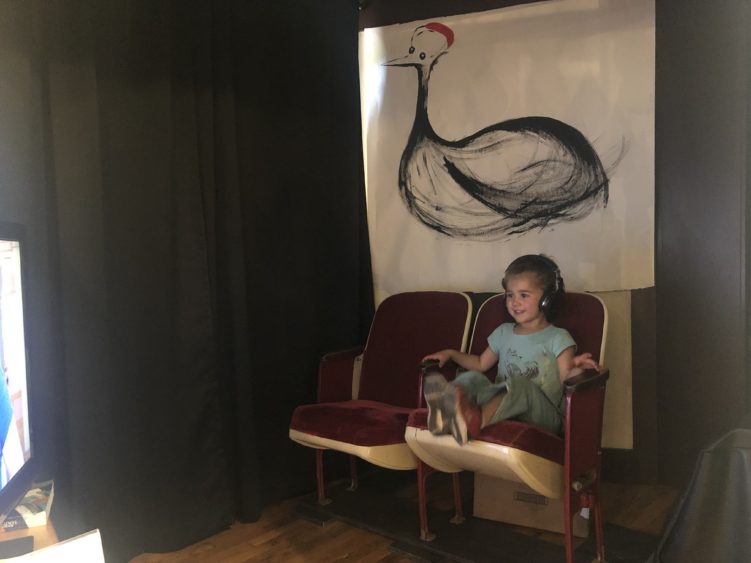Celebrating the Natural Assets of Our Rivers and the Collective Work of Scientists, Stakeholders, and Artists
The 70ft long mural illustrating the Yampa River from the Flat Tops to Dinosaur National Monument was the center of the Exhibition. An opportunity for visitors to see, touch and feel it, before its installation on a wall downtown, guarding the River from up high. The mural is the product of a successful collaboration between local artist Jill Bergman and Friends of the Yampa, providing a panoramic view of the river, its different landmarks and its ecological, recreational, agricultural, municipal, and industrial attributes.
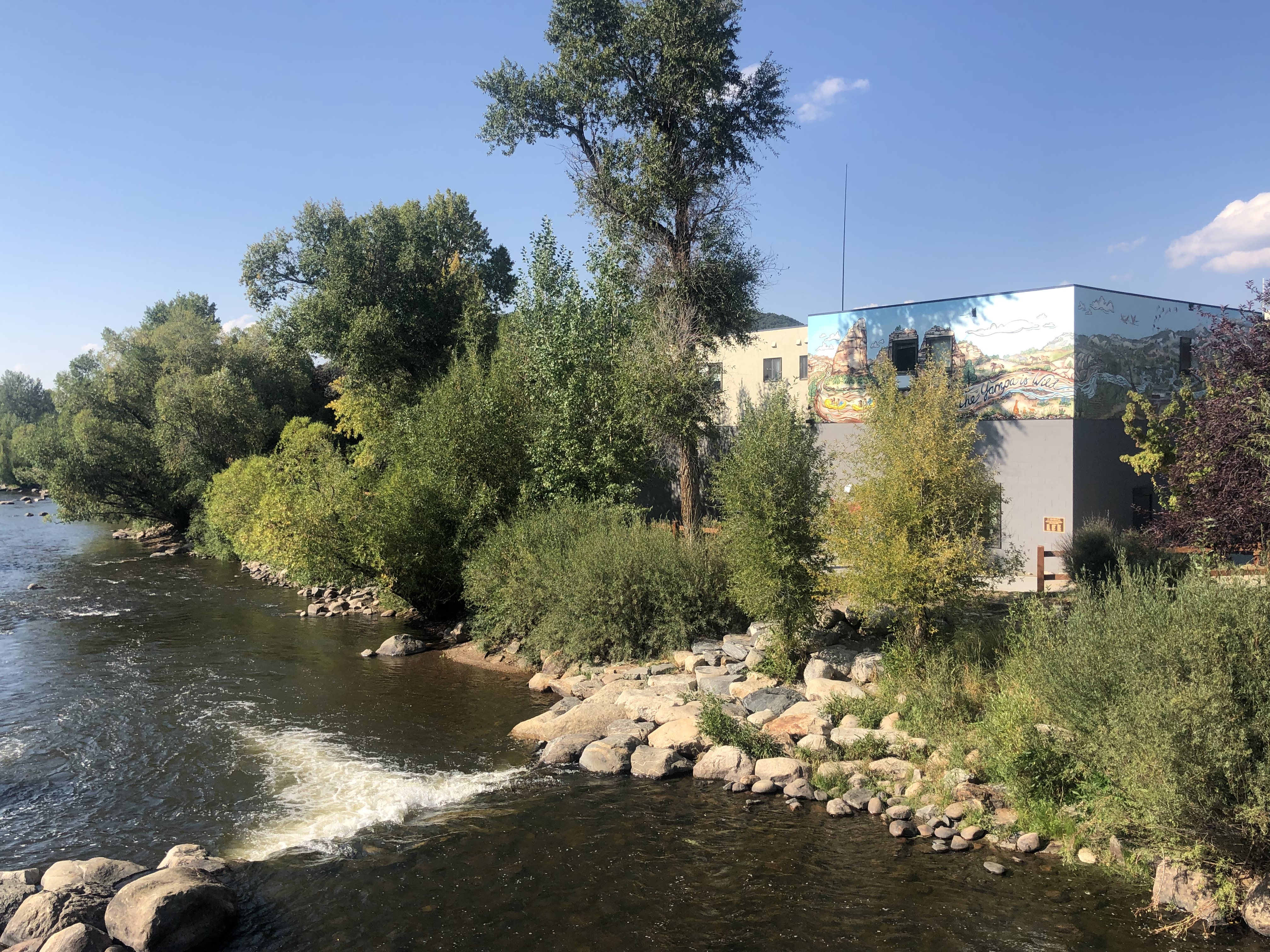 See the engaging concepts from both the arts and sciences behind river management through a new lens here:
See the engaging concepts from both the arts and sciences behind river management through a new lens here:
Inspired and made possible by the vision and support of Nature, Environment, Science and Technology Studio of the Art (NEST) at CU Boulder, the Yampa River Art & Science Summer Exhibition brought the Yampa Valley Community together in honor of its beloved river and in support of its restoration and protection.
As prioritized in the 2018 Colorado Water Plan, such an interactive event ”increases the recognition of the significant role that the Yampa River plays in providing consumptive and non-consumptive needs and water to meet Colorado’s downstream compact obligations”.
“ No single entity is accountable for or has jurisdiction over the health of the Yampa River – it’s not just up to the City of Steamboat Springs, or Routt County, or the Upper Yampa Water Conservancy District, or Colorado Parks & Wildlife, or any other agency to single-handedly safeguard our community’s river. That’s why entities and individuals in this basin have to work together to preserve and restore the health of the Yampa River and the lands and waters that contribute to it.” Kelly Romero-Heaney, Steamboat Springs City Water Manager.”
With a comprehensive representation of partnering organizations and science-based initiatives illustrated by emerging and established artists, the exhibition created a unique opportunity for increasing watershed function and water management literacy, dialogue, and action:
The water drops at the center drizzling over the linocut block, utilized to create the mural, represent the numerous partners involved in the Yampa River management as quoted above. To the upper left are photographs by Marty Ralph, Director of the Center for Western Weather & Water Extremes at SCRIPPS Institution of Oceanography, and postdoctoral student, Tom Curringham, attending the Yampa Basin Rendez-Vous, which illustrate weather patterns common in the Basin. Below, a funnel of GIS maps symbolizes the Fish Creek Watershed Wildfire Risk Assessment study featured in the Community Protection Plan. To the upper right are humoristic and historical explanations of the Colorado River Compact and its impact on Colorado water management today; descriptions of the four native endangered fish species managed by the Upper Colorado River Endangered Fish Recovery Program, the 10 river health factors evaluated in the Yampa River Health Assessment & Streamflow Management Plan, the goals of the Yampa-White-Green Basin Implementation Plan described by River Network, and a summary of a study of Contaminants of Emerging Concerns in Dinosaur National Monument. The three small frames illustrate water temperature management opportunities summarized in the Yampa River Health Assessment & Streamflow Management Plan.
Connecting through photography and narratives can help understand and identify with individuals who value the river for different reasons –and bring the community together:
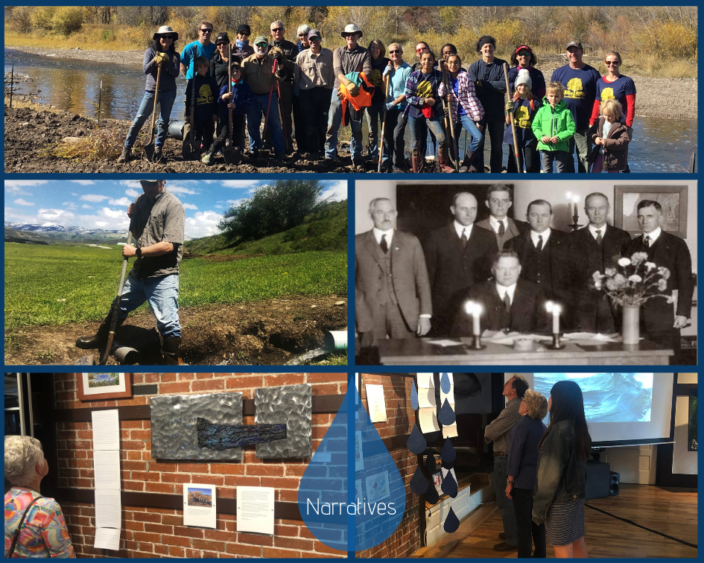
At the top is a photograph of volunteers participating in the riparian restoration organized by the Yampa Valley Sustainability Council Retree Program in partnership with the City of Steamboat Springs, Colorado State Forest Service, and Parks and Wildlife. Middle left is a photograph of Patrick Stanko, 4th Generation Yampa Valley Rancher sharing his life experience of irrigating on his family ranch. Middle right is a photograph of members of the Colorado River Commission at the signing of the Colorado River Compact, 1922, from the Western Collection of the Denver Public Library. Bottom left is a narrative from Betsy Blakeslee “Sharing Our Place On The Yampa”, former facilities manager at the Carpenter Ranch managed by the Nature Conservancy. Bottom Right, visitors reading Lauretta Davidson’s connection to the Yampa River as a sheep and cattle rancher and weaver.
Artists share their connections and concerns for water pollution through inspiring pieces and statements: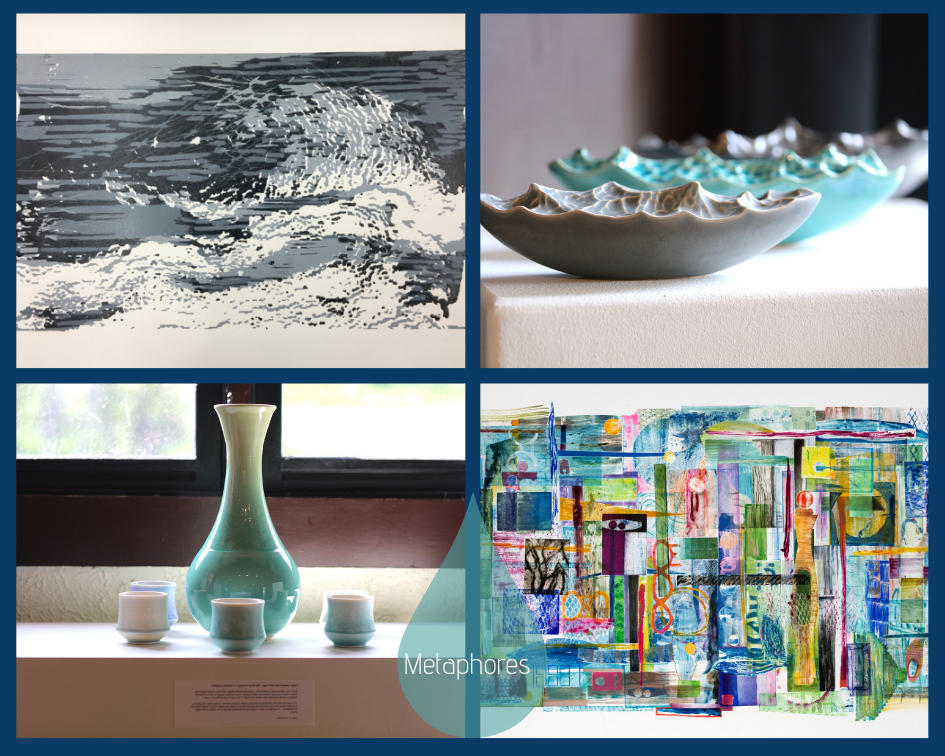
Top left, Surge, woodblock print from an image of a wash of water on clear Mylar by Mason Cessna. This wave represents the intense surge of data and information that can be manipulated and processed to create whichever man can and will desire. This print takes the overwhelming concept of data manipulation and information control and synthesizes it into a tranquil wave, appreciating the subtle nature of water. Water can be detrimental and destructive as well as life supporting and imperative to survival.
A Two-fold metaphor, bottom left, Large Vessel Form with Cups – The River Fortress, by biologist and artist, Julie Anderson: Each cup, representing a contribution, is poured into the vessel, the Yampa River Fund. As the level in the vessel rises, a precious communal reserve grows. This monetary supply is vital to efficiently address current pressures and assure the health of the river for generations to come.
The cups can also be perceived as tributary creeks draining into the Yampa River. By assuring that each cup is filled and consciously poured into the vessel, the health of the Yampa River will be sustained. The quality of water in each cup contributes directly to the vitality of the larger vessel. Every spring, I am drawn to the Yampa River and its tributaries to observe the crashing repeat of waves over water eroded boulders. The movement of water in a rushing river is a reminder of our ever-changing environment. The swirling spirals and curls seen in many of my sculptures are inspired by patterns observed in water.
To the bottom right, The Pacific Patch Elevator, oil and watercolor monoprint by Sue Ohme, using mostly recycled and discarded materials. More and more, I have felt compelled to not throw anything away, thus all these random packaging/marketing material are now embedded in my work…/… Hopefully, the inference I am searching for is clear. It is well past time for all of us as humans to face this man-made crisis, and find compromise to redirect the course of climate change, water management, and pollution.
Visitors of all ages participate in artistic and scientific activities through various interactive stations: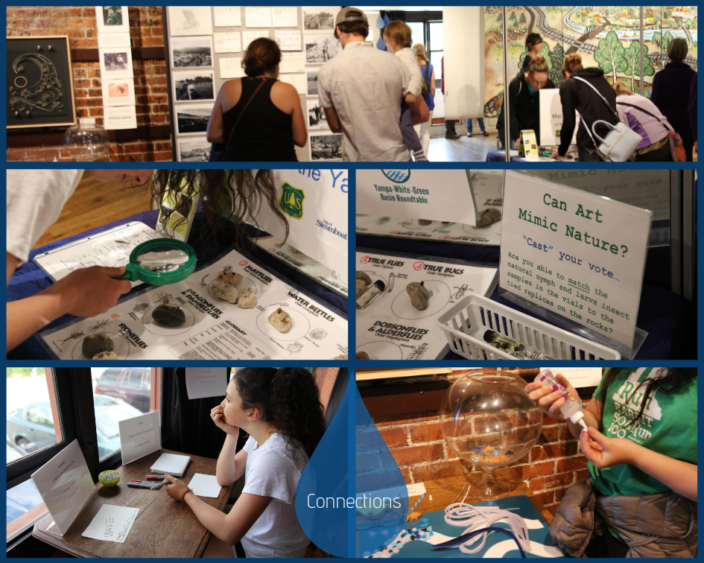
After writing their own Yampaku depicting their connections to the river while sitting at a desk in a cove facing the river, visitors posted their connections on a board bordered by historical photographs illustrating our connections to the river “Then & Now”. Volunteers at Yampatika created a station for children to match larvae to flies which are indicators of a healthy river. Visitors create an artistic paper quilling version of the Yampa River Fund logo.
Youthful views of the Yampa River: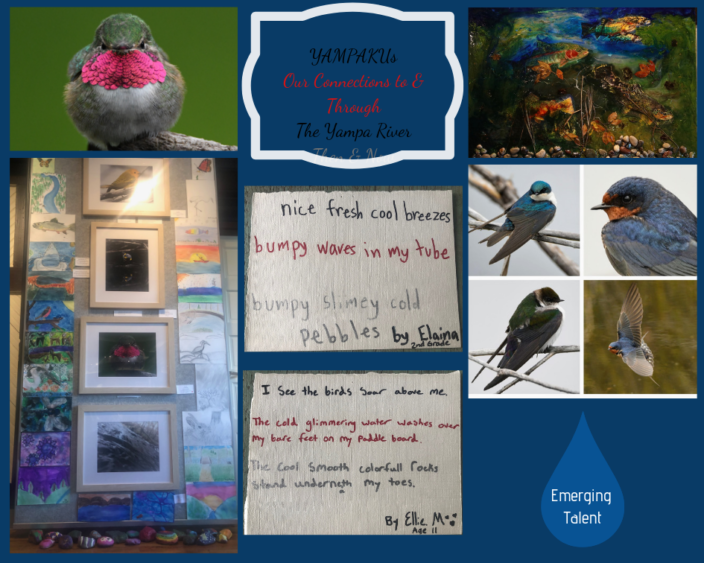
Photographs of a Selasphorus platycercus, and collage of swallows were taken at the local Skate Park next to the Yampa River by Grey Barbier, 12 years old. Bottom left, is a collection of drawings from Steamboat Springs Middle School students from science teachers Garret Bock and Bennett Colvin created during field trips. Beneath The Surface, top right, is an encaustic piece by young, avid fishermen Braden Duty and Mateo Bartels, sponsored by Bucking Rainbow Outfitter. A sample of “Yampakus” from elementary school students is at the center.
Acclaimed views of the river: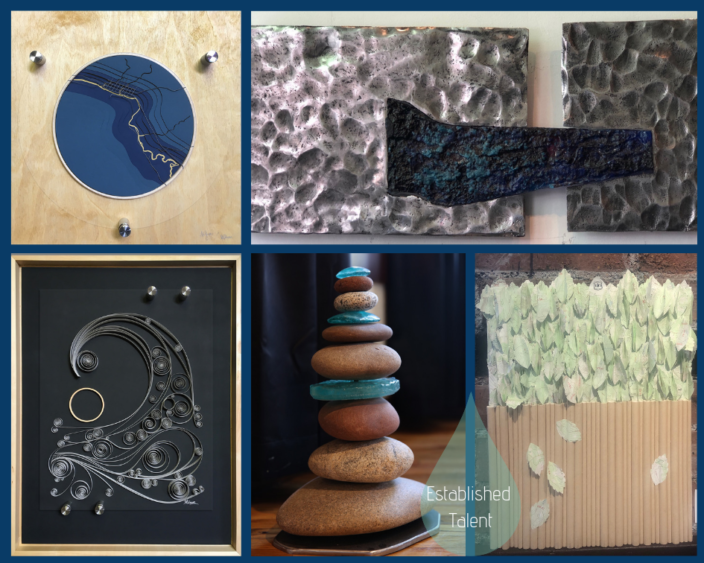
Top left, Connection, paper on wood, a topographic representation of the Yampa River by artist Paulina Johnson and Andrea Grygo, Colorado Mountain College GIS Adjunct Professor. Bottom Left, Standing Wave, paper on wood by Paulina Johnson. Top right, Fractured Stream, casted aluminum and glass by glass artist Jennifer Baker and sculptor David Marshall. Bottom Center, Cairn Prototype, stone, metal and glass, a collaborative project between Emmanuelle Vital, Leo Atkinson & Jennifer Baker to create cairns with the community to install in environmental and cultural points of interests within city limits. Bottom right, Forrest for the Trees, recycled Routt County maps by Kim Keith, With every walk down the core trail adjacent to the Yampa River you will find trash. Turning trash into art allows these materials to be transformed into vehicles for a conversation about conservation of our waterways and our environment, particularly our sacred Yampa River and the streams that feed it.
The movie “Flow” was premiered at the exhibition’s opening:
River Poetry: Filmmaker and instructor at the Mountain School, Charlie Smith, filmed the Yampa River throughout the winter and spring up close.
High school students, Mason Voyvedic and Louis Bartels interviewed local water managers:(including Kelly Romero-Heaney, Water Resource Manager, City of Steamboat Springs, Todd Hagenbauch, Extension Agent, Colorado State University, Bill Atkinson, Aquatic Biologist, CO Parks & Wildlife, Kent Vertrees, President, Friends of the Yampa and mural artist Jill Bergman)
Above, Crane painting by Norma Ryan.
“Having grown up fishing and playing in the Yampa River, we wanted to document other people’s connections to the river. We learned so much about the complexity of its management locally and in Colorado. It makes me want to learn more about water law.” Mason Voyvedic
A glimpse at the vision, enthusiasm, and smiles behind the scene: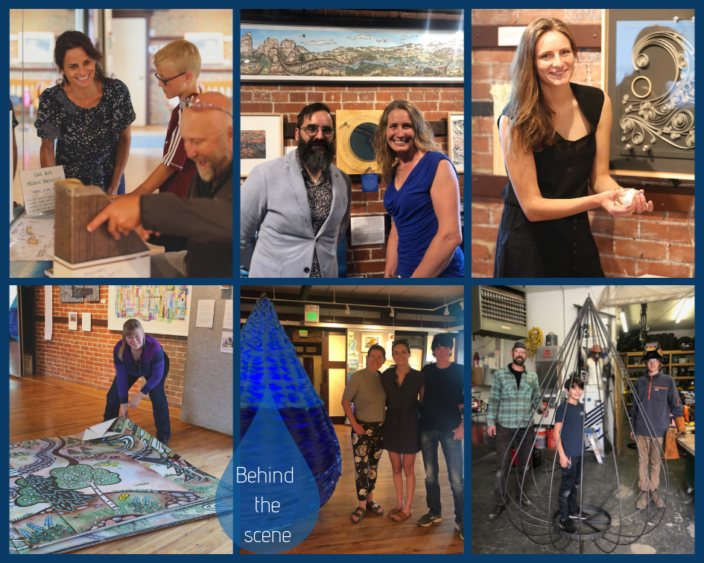
Top right, Madison Muwxworthy, exhibition coordinator, YVSC Waste Management Director, recent graduate of Colorado Mountain College Sustainability Studies. Center, Jorge Perez-Gallego, Professor in Astronomy, Artist and co-investigator, NEST, Studio for the Arts, CU Boulder, with Andrea Grygo, GIS Adjunct Professor. Top left, Emmanuelle Vital, exhibition curator, with volunteers from Yampatika. Bottom left, artist Jill Bergman. Bottom center: artist, Madison Muxworthy & Mason Voyvedic. Bottom Right, the Bartels boys putting to practice their new welding skills learned from local instructor, Kevin Kleckler, to build a giant water drop.
A small sample of visitors’ comments:
“Excellent concept, artwork and information!” Pam Pierce
“Thank you for providing a window into the myriad ways the river provides for the community and emphasizing the importance of protecting it” Benjamin Hatchett
“This was such a worthwhile endeavor! So very interesting. Terrific Exhibit.” Anna Lee Lipman
From the curator: The exhibition would not have been possible without the participation of devoted volunteers and the generous support of passionate water professionals-who never refused to answer endless questions! Thank you for demonstrating such strong stewardship across the community.
As we go further into the Anthropocene, the urgent need for local to planetary stewardship is imperative to reverse the degradation of ecosystems and its threat to the resilience of the Earth’s systems. By working across disciplines and connecting experts to a wide range of community members, we can alter our relationship with each other and our planet, and create lasting, positive change on a global scale.
In the news: Steamboat Pilot Today, Interactive Exhibit Combines Art, Science to Inspire Community Support of the Yampa River
Upcoming Presentations: Professor Jorge Perez-Gallego and Emmanuelle Vital will present at the Creative District Leadership Conference sponsored by CU Boulder Office for Outreach and Engagement and Colorado Creative Industries, Thursday, October 24, 2019.
Emmanuelle Vital will present at Engaging Climate Change Through the Arts – An Inclusiveness and Equity Series featuring environmental and artistic projects followed by conversations with panelists about how the arts can shape beliefs and actions. Moderated by Mitch Tobin, Director, The Water Desk, CU Boulder Center for Environmental Journalism, Wednesday, October 23, 2019.
Photographs: courtesy of LaRock Star Creative.
